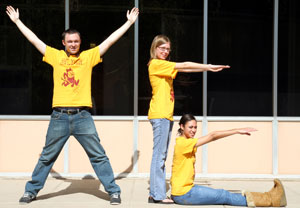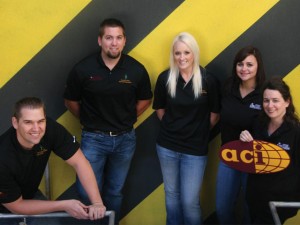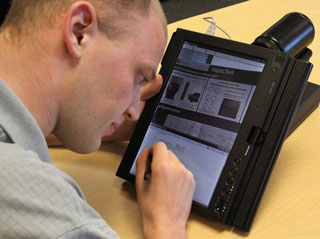
Pursuing a path to success
Student clubs and professional organizations
American Concrete Institute (ACI)
American Indian Science and Engineering Society (AISES)
American Institute of Aeronautics and Astronautics (AIAA)
American Institute of Chemical Engineers (AIChE)
American Society of Civil Engineers (ASCE)
American Society of Heating, Refrigeration, and A.C. Engineers at ASU (ASHRAE)
American Society of Mechanical Engineers (ASME)
Associated General Contractors of America Student Chapter (AGC)
Biomedical Engineers Society (BMES)
Bridges to Prosperity
Chi Epsilon (XE)
Construction Students Abroad
Daedalus Astronautics
Engineering World Health
Engineers Without Borders
Eta Kappa Nu, International Honor Society for Electrical Engineers
Fulton Engineering Student Council
Game Development Studio
Institute for Operations Research and Management Science (INFORMS)
Institute of Electrical and Electronics Engineers (IEEE)
Institute of Electrical and Electronics Engineers Computer Society (IEEECS)
Institute of Industrial Engineers (IIE)
Linux Users Group
Material Advantage at ASU
National Association of Home Builders (NAHB)
National Society of Black Engineers (NSBE)
North American Society for Trenchless Technology (NASTT)
Sigma Lambda Chi, ETA Chapter, International Construction Honor Society
Society of Automotive Engineers (SAE)
Society of Hispanic Professional Engineers (SHPE)
Society of Mexican American Engineers and Scientists (MAES)
Society of Women Engineers (SWE)
Software Developers Association at ASU (SoDA)
Tau Beta Pi
Theta Tau
Women in Computer Science
Student organizations and teams help close the gap between the classroom and the workplace—and for many, provide a way to reach out, give back and have fun.
ASU is home to over 35 engineering student organizations ranging from honors and professional associations to groups building racecars or programming robots.
“Student organizations fill an important role in the educational experience,” says Wade Gyllenhaal, president of the ASU student chapter of the Society of Automotive Engineers. “We provide opportunities for early hands-on experience, introductions to industry and important networking connections.”

Members of Chi Epsilon, the Civil Engineering Honor Society
Devin Bulyer, a freshman, credits Women in Computer Science with helping her transition to college and life away from home. She says the group was a great way to meet friends, find tutors and get to know faculty. Plus, she says it’s fun and she still feels like she is doing something important.
Importance of getting involved
Recent graduate Chase Farnsworth says that participation in the Associated General Contractors Chapter (AGC) at ASU provided him with “great opportunities to team up with local contractors to provide service to the community and learn at the same time.”
Most of the organizations do have an outreach component as well, helping to bring engineering into elementary, middle schools and high schools.
Brian Perea, a member of the Society of Hispanic Professional Engineers (SHPE) says that the group works in conjunction with the Mathematics, Engineering, Scientific Achievement (MESA) program, a free after-school educational program whose purpose is to assist underserved ethnic minorities, girls, low income, and first generation college-bound students pursue course work, advanced study and possible careers in math, engineering and science. SHPE members work with younger students on projects making water bottle rockets, solar ovens and paper bridges.

ASU received an Excellent University Award from the American Concrete Institute in 2011, in part due to the strength of our student organization.
Winning Team: Team Note-Taker
A team of Ira A. Fulton Schools of Engineering students will be competing in the world’s premier student technology contest in New York City, July 8-13.
Team Note-Taker earned a place in the Microsoft Imagine Cup Worldwide Finals by taking the top prize in the U.S. National Imagine Cup event April 11 in Seattle, Wash.
The students’ project is a portable custom-designed camera with a touch-screen tablet PC that aids visually impaired students. It has been developed in the Fulton Engineering Schools’ Center for Cognitive Ubiquitous Computing (CUbiC).
Led by graduate student David Hayden, the team includes computer science students Michael Astraukas, Qian Yan and Shashank Srinivas. They’re mentored by CUbiC lab director John Black.
The team entered the Software Design division of the event, the Imagine Cup category in which competition is considered the toughest, Black says.
Two other teams of computer science students in the School of Computing, Informatics, and Decision Systems Engineering competed in the national finals.
Team EDO Ryan Scott and Travis Sein finished in fourth place in the competition’s Mobile Game Design category. They developed a game called Word Mine as a mobile-phone application, aimed at making it fun to learn vocabulary, spelling and different languages.
ASU Team Transit Trackers Kevin Putman, German Greiner, Steven Hernandez, Arash Tadayon competed in the Software Design category. The team developed technology for a prototype of information network to make it easier for people—especially the visually impaired—to use public transit.




































